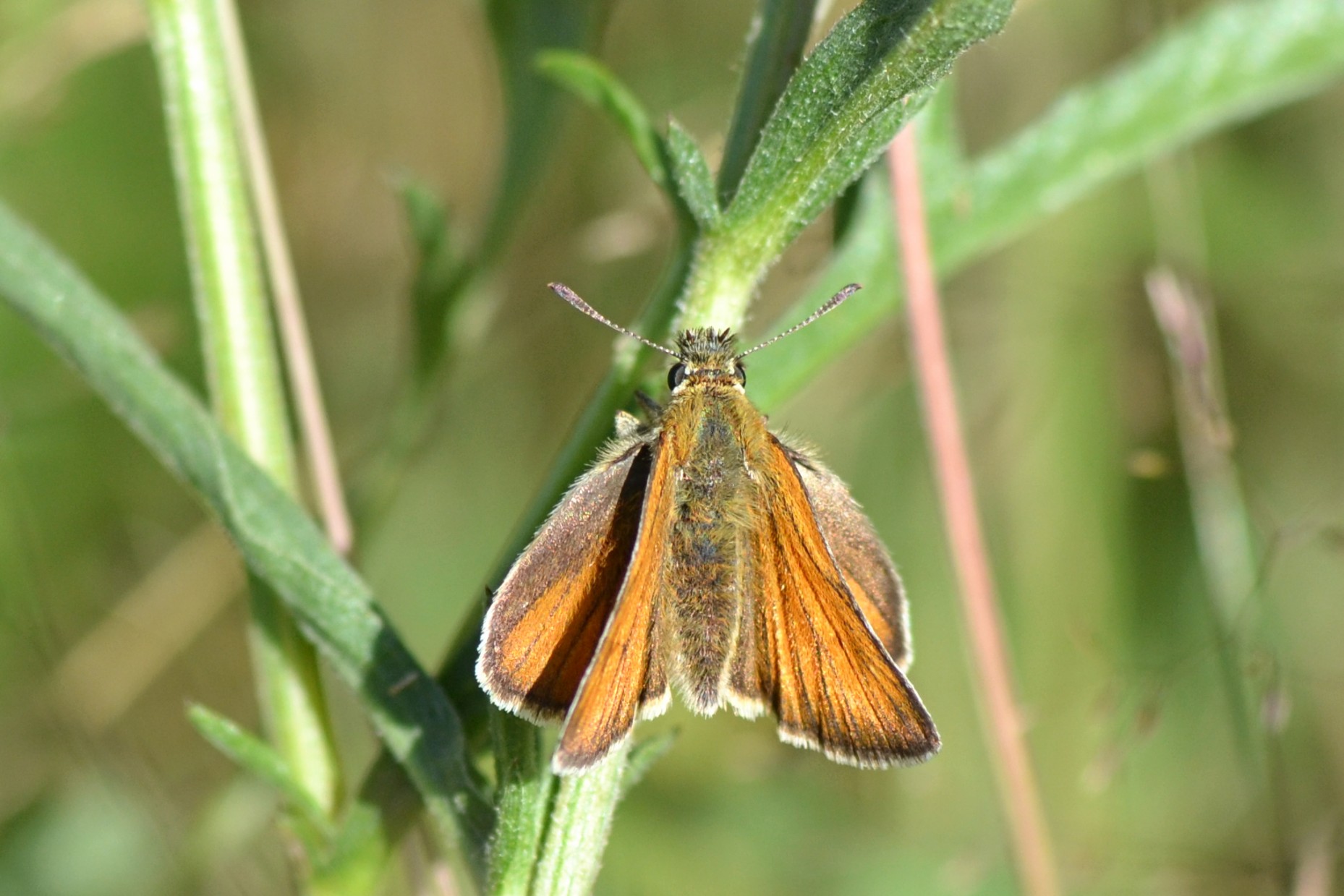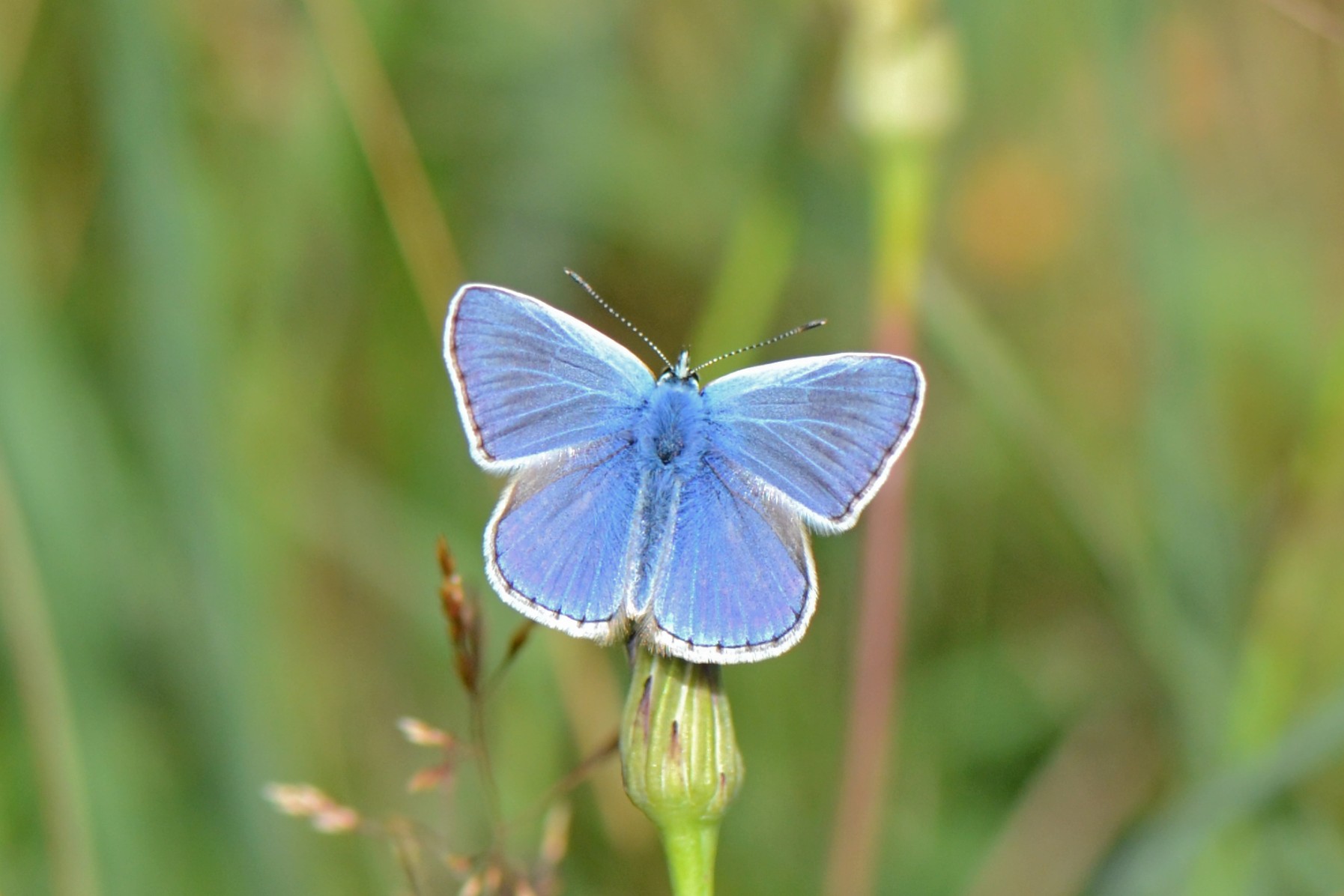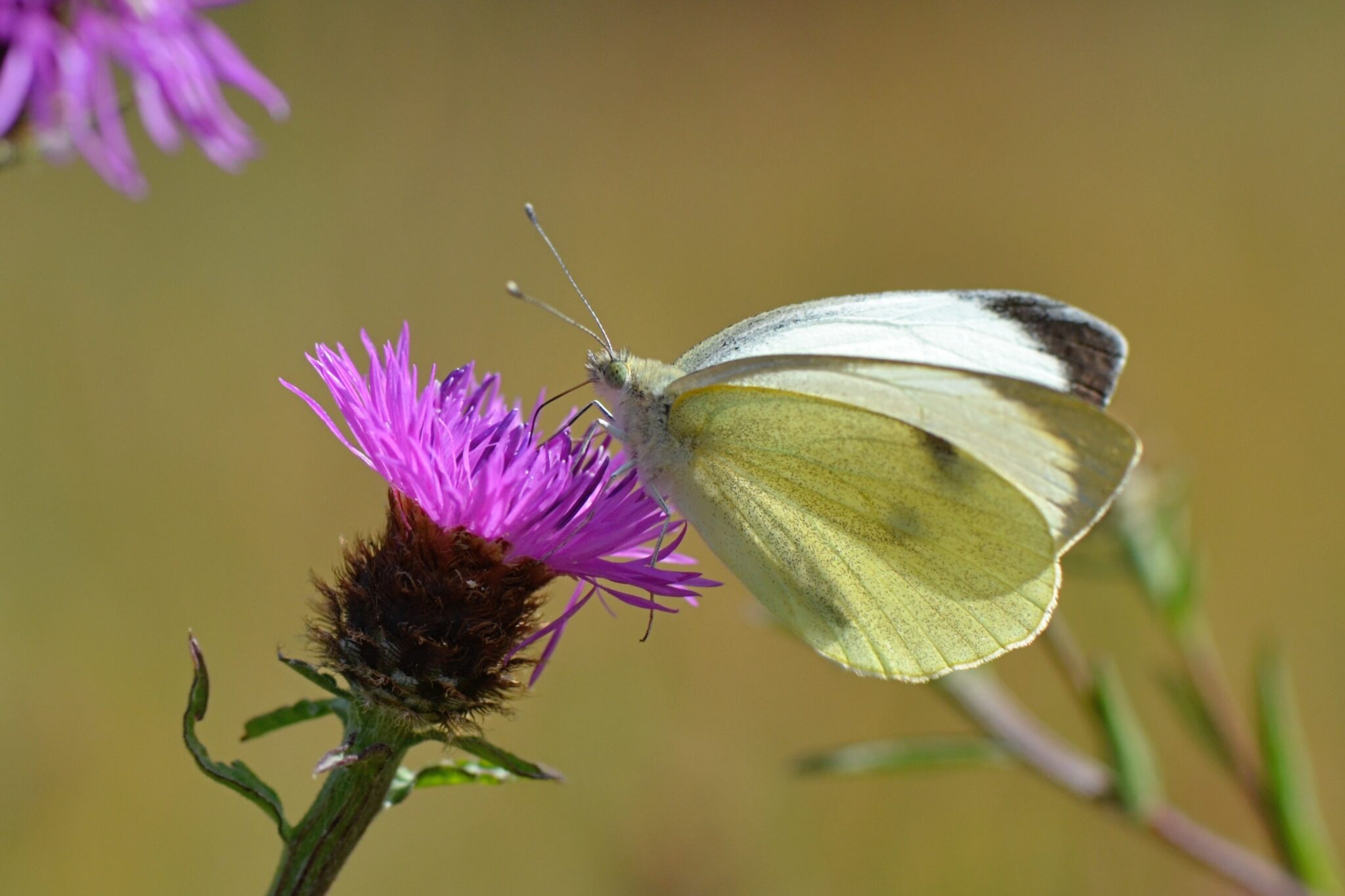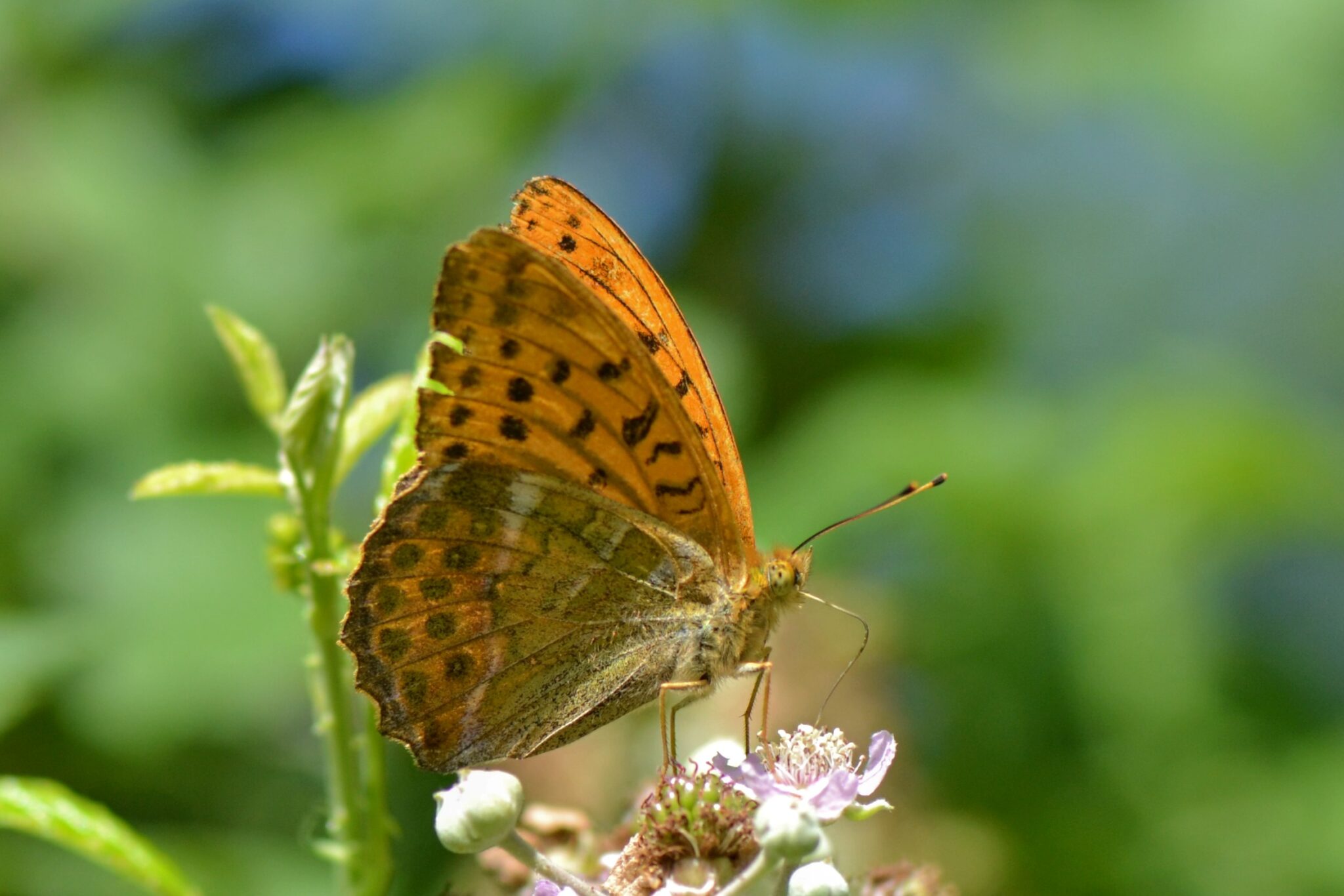It’s high summer, and the hot sun beats down from a cloudless blue sky as I walk through the flower-filled meadow, with butterflies swirling all around me. Some alight on the nearby Knapweed flowers to feed, so I have a brief chance to get a better look at them. There’s Meadow Browns mostly, plus Marbled Whites with their gorgeous black and white chequered wings – one of my favourite species! A few amber-coloured Small Skippers whizz by too.


It’s so peaceful the only sounds I can hear are the distant cooing of a Stock Dove from the nearby Copse, the gentle buzz of Bees, the rasping chirp of countless Grasshoppers, and my feet brushing through the tall, dry grasses as I criss-cross the meadow from hedgerow to hedgerow. I have time to notice how the meadow has changed colour since mid-summer. The glorious swathes of golden-yellow Buttercups and white Oxeye Daisies that filled the meadow in early June have been replaced by tall tawny grasses and purple Knapweed, dotted here and there with the occasional Oxeye Daisy still in flower.

Suddenly I see a flash of bright blue, as a male Common Blue flies by in pursuit of a female. She’s a very different colour to the male, with brown wings dusted blue, and orange spots dotted along the outer margins. I pause to add them to the tally, because I’m not here just to enjoy myself (though I am, of course!), I’m here on a butterfly transect, recording all the butterflies I see on a set route around the meadow and wood.
Reaching the far hedgerow I spot a Gatekeeper nectaring on Bramble flowers. Also known as the Hedge Brown, it’s a well named butterfly as it’s almost always found by gateways and along hedgerows and field margins. Turning away I set off to cross the meadow three more times, adding more species to the list, including a beautiful Painted Lady, some Large Whites and a Brimstone, but mostly I’m recording Meadow Browns!


It’s quite a relief to leave the simmering heat of the meadow and step into the cool shade of the Lime tree and out onto the track. Under the tunnel of trees it’s too shady for butterflies, but every now and then the tree canopy opens up enough to let in some dappled light, and it’s here that I see Speckled Woods, which thrive in these places. As I’m heading for the Northwest Frontier it’s not long before I’m on a more open ride. In the bright sunshine a large golden-brown butterfly charges towards me at speed and swoops past at head-height. It’s a male Silver-washed Fritillary. Such a stunning butterfly (and another favourite!).
Carrying on along the ride I remember to look up into the lower tree canopy, and can’t believe my luck when I spot a Purple Hairstreak. It’s sitting on an Oak leaf with wings firmly closed, so I get a good view of its pale silver-grey underwings, and can even see the orange eyespot from where I am standing. These butterflies usually live high up in the Oak tree canopy, feeding on aphid honeydew, and only rarely come down to ground level, so I’m thrilled to see this one so close up. But I mustn’t linger for a moment longer, though, as stopping isn’t allowed on transect!


It’s baking hot in the Northwest Frontier. There’s not a breath of wind, and the young trees hardly cast any shade. As I walk along the open grassy rides Grasshoppers flee from under foot, and Meadow Browns flutter over the grasses, in search of their caterpillar food-plants. I notice another golden-brown butterfly, but this time it’s a Comma, with beautiful scalloped wing edges. It lands on a dark Bramble leaf, closes its wings and seems to disappear. The wavy edges and cryptic brown underwing colours are a perfect camouflage, resembling the leaf it is sitting on. Only the white comma, which marks the lower hind underwing, and gives this butterfly its name, betrays its presence.
Leaving the Northwest Frontier I set off down another dark tunnel of trees. Tall trees crowd the narrow, winding path, so at this time of year, with the trees in full leaf, little light reaches the woodland floor. Not a good place for most sun-loving butterflies, but there’s a few places where shafts of sunlight beam down, and sure enough I spot some Speckled Woods basking in these little patches of sun.


Out again on more open rides I spot many more butterflies. Most are nectaring on the Bramble flowers that grow alongside the rides here. A brightly coloured Peacock and more lemon-yellow Brimstones are added to the tally, and I see the most Ringlets that I‘ve seen so far, as they prefer the slightly damper rides. Another dark tunnel of trees and then I’m out in the open again, passing by the still, tranquil pond. The water sparkles in the midday sun, dazzling my eyes, and I smell a slight sea-weedy aroma which reminds me of the sea.
No butterflies here, but large Dragonflies hawk over the water, and delicate red and electric-blue Damselflies dart like needles over the rushes and sedge that frill the pond margins. But there’s no time to stop and stare, and I continue on, through the Dancing Circle, where bright pink Betony flowers stud the grass and various butterflies abound. Beside the Dark Wood the open ride climbs uphill. It has been scythed quite recently, so there aren’t many flowers, but I still see a few butterflies here, including the last Silver-washed Fritillary of the transect. At Southern Cross I head north, under thickly planted Hazels, then out onto the car park, where a few more butterflies loiter in the hot sunshine. And my transect is done!
In the past hour I have recorded 14 Butterfly species, seen over 300 butterflies, and enjoyed every minute! Back home the data I recorded will be submitted to the UK Butterfly Monitoring Scheme (UKBMS). One of the longest running insect monitoring schemes in the world, the data collected by the UKBMS is gathered through a network of citizen scientists walking designated transects, and the resulting dataset is one of the most important resources for understanding changes in our butterfly populations.
The Hazel Hill transect was started by Conservation and Education co-ordinator Charley Miller in 2019. Divided into eight sections, it covers the different habitats and micro climates within this very special woodland and meadow setting. The transect is walked weekly from April to September, weather permitting – for butterflies are fair-weather creatures! The data collected will measure long-term changes in butterfly abundance and variety, and can be used to inform conservation management, and the effects of weather and climate change.

I only started helping Charley with the transect three summers ago. Back then I was unfamiliar with the wood, so it took awhile to become totally familiar with the route. Now I know it like the back of my hand (I even know where most of the trip-hazards are, so mostly avoid them these days!). It’s been wonderful getting to know the meadow and wood’s fantastic flora and fauna, and feeling as though I’m making a small contribution to helping our beleaguered butterflies.
With an alarming 80% decline of our UK butterflies, due to habitat loss and fragmentation, pesticide use and climate change, it’s such a relief to see that Hazel Hill wood and meadow is providing a safe haven for these enchanting creatures.
Story and photographs by Diana Cotter, Hazel Hill Volunteer.

